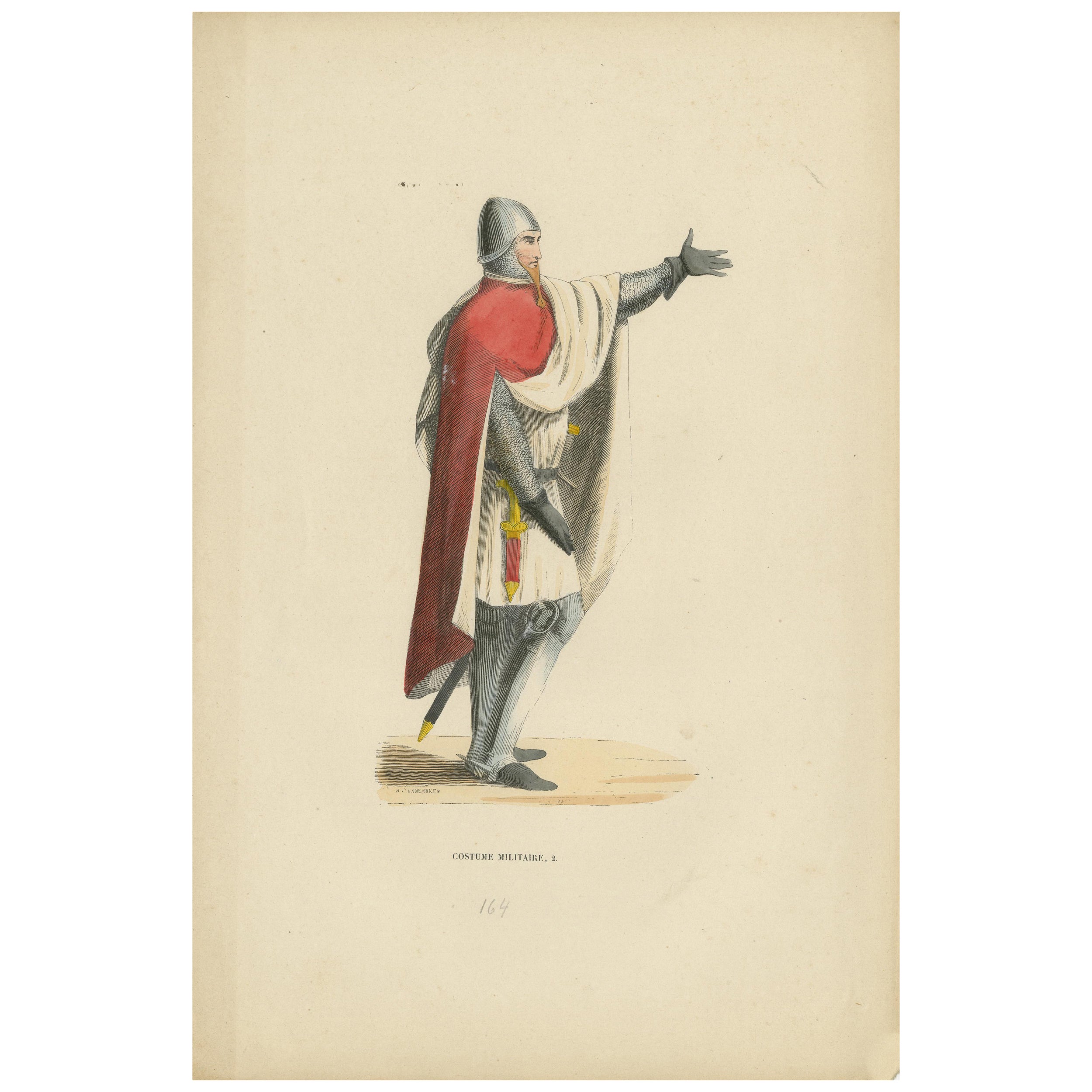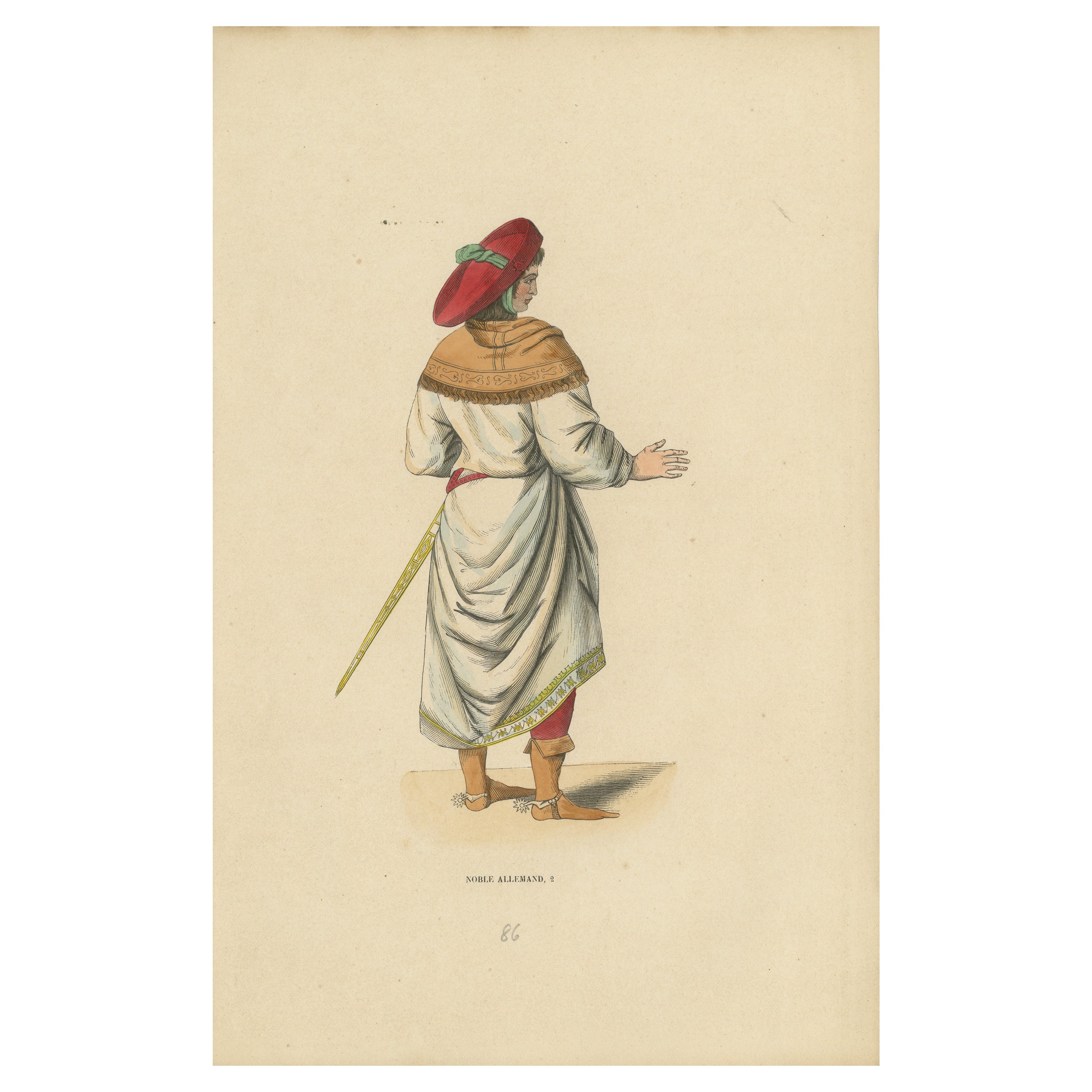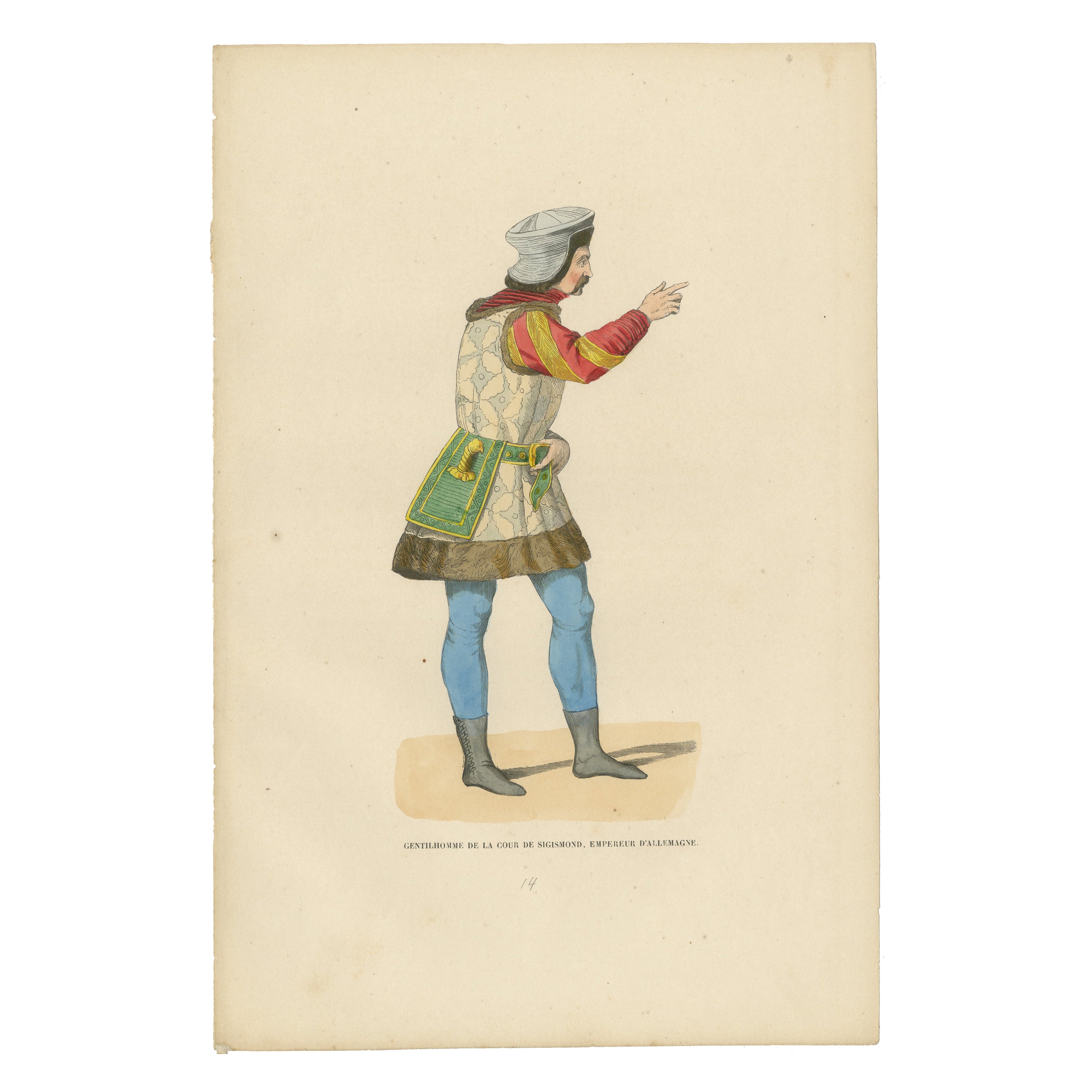Items Similar to Seated Spanish Nobleman: The Visage of Authority, 1847
Want more images or videos?
Request additional images or videos from the seller
1 of 6
Seated Spanish Nobleman: The Visage of Authority, 1847
About the Item
Title: "Seated Spanish Nobleman: The Visage of Authority"
Description: This original antique detailed print portrays a Spanish nobleman from the Middle Ages, seated in a commanding position that denotes his high social status and authority. He is depicted in a stately pose, exuding an air of confident repose that reflects his powerful position within the societal hierarchy.
The nobleman is dressed in a long blue tunic, a color often associated with nobility and depth of character. His tunic is complemented by a rose-colored undershirt, a combination that suggests both wealth and taste. Over his attire drapes a heavy, deep blue cloak, a mark of his status, which provides both warmth and an impression of gravitas.
On his head, he wears a broad-brimmed green hat, which is both a stylish and practical accessory, shading his eyes and symbolizing his affinity with the outdoors and perhaps his participation in hunting, a favorite pastime of the nobility.
His footwear consists of red shoes, possibly made of fine leather or velvet, adding a striking contrast to his ensemble. The nobleman's demeanor is one of contemplation, with a hand resting on a money pouch at his belt, indicating his control over wealth and economic affairs.
The chair in which he sits is adorned with simple yet elegant ornamentation, including a valance with floral motifs, signifying a connection to nature and his domain. The setting is minimalistic, focusing the viewer’s attention on the nobleman’s figure and attire.
Through this print, we gain insight into the fashion and symbols of status that were prevalent among the Spanish nobility during the Middle Ages. It is a snapshot of power, heritage, and the cultural significance of attire as a reflection of one's role in society.
The colors have a nice glow over them. Historically, egg whites, known as glair, and sometimes egg yolk were indeed used in illumination and painting, particularly in manuscripts, to give colors a brighter appearance and to add a sheen or gloss to the work. This technique was quite common during the Middle Ages and into the Renaissance.
Egg whites can be applied as a varnish over pigments to enhance their brightness and to protect the colors. This application could make the colors appear more vivid and also add a slight glossy sheen to the surface of the image.
Egg yolk, on the other hand, was commonly used as a binding agent in paint. It forms the basis of tempera paint, a medium that was widely used before the advent of oil painting. Egg yolk helps to create a durable and long-lasting color that adheres well to various surfaces.
In the context of the print from 1847, it's less likely that egg whites or yolks were used directly on the print, as by that time, commercial printing processes would have been more advanced and less reliant on such manual methods. However, if this print is a representation of an earlier style or is meant to mimic the appearance of hand-painted manuscripts, the original artists might have employed techniques or materials that gave a similar effect to those achieved with egg-based binders and varnishes.
- Dimensions:Height: 10.63 in (27 cm)Width: 7.09 in (18 cm)Depth: 0 in (0.02 mm)
- Materials and Techniques:
- Period:
- Date of Manufacture:1847
- Condition:Good. Overal light toning and light soiling but the image itself clean and hand-colored almost 200 years ago and still in expliciet colors. Aged paper with typically warm, yellowish-brown hue, mostly around the edges. Study the images carefully.
- Seller Location:Langweer, NL
- Reference Number:
About the Seller
5.0
Platinum Seller
These expertly vetted sellers are 1stDibs' most experienced sellers and are rated highest by our customers.
Established in 2009
1stDibs seller since 2017
1,932 sales on 1stDibs
Typical response time: <1 hour
- ShippingRetrieving quote...Ships From: Langweer, Netherlands
- Return PolicyA return for this item may be initiated within 14 days of delivery.
More From This SellerView All
- Florentine Nobleman of the Middle Ages, 1847Located in Langweer, NLTitle: "Civilian Costume at the End of the 15th Century" Description: The image is a print from a series the "Costume du Moyen Age" dated 1847, and titled "Costume Civil de la Fin d...Category
Antique 1840s Prints
MaterialsPaper
- The Medieval Herald: A Portrait of Authority and Message, 1847Located in Langweer, NLTitle: "The Medieval Herald: A Portrait of Authority and Message" Description: This print depicts a medieval herald, an essential figure in times of war and peace for communication ...Category
Antique 1840s Prints
MaterialsPaper
- German Nobleman of the Middle Ages: Elegance in Profile, 1847Located in Langweer, NLTitle: "German Nobleman of the Middle Ages: Elegance in Profile" Description: This vibrant print, original antique and hand-colored, presents a German nobleman from the Middle Ages,...Category
Antique 1840s Prints
MaterialsPaper
- The Gallant Courtier: A Nobleman's Fashion in 'Costume du Moyen Âge, 1847Located in Langweer, NLTitle: "The Gallant Courtier: A Nobleman's Fashion in 'Costume du Moyen Âge'" Description: This 1847 lithograph from the "Costume du Moyen Âge" collection depicts a nobleman dressed...Category
Antique 1840s Prints
MaterialsPaper
- Sergeant at Arms in Ceremonial Garb: Symbol of Authority and Protection, 1847Located in Langweer, NLThis hand-colored engraving, titled "Sergent d'Armes," depicts a Sergeant at Arms from the Middle Ages, a role that historically combined duties of law enforcement, security, and ceremonial functions within the royal court. The figure stands in a poised and authoritative stance, dressed in a rich blue doublet with full sleeves, edged with a yellow patterned trim that denotes his official capacity. The doublet is belted at the waist, accentuating the length of the garment which falls to the mid-thigh, a typical fashion of the period for men of status. Over the doublet, he wears a cape that drapes over one shoulder, suggesting readiness for action. The cape, matching the doublet in color and trim, reinforces his dignified position. His hose are golden, fitting snugly and shimmering in contrast to the matte finish of the doublet, indicative of the esteem of his office. The sergeant...Category
Antique 1840s Prints
MaterialsPaper
- Courtly Splendor: A Nobleman at Emperor Sigismund's Court, 1847Located in Langweer, NLThe image depicts a man identified as a "Gentilhomme de la cour de Sigismond, empereur d'Allemagne," which translates to "Gentleman of the court of Sigismund, Emperor of Germany." This individual is portrayed in a profile stance, dressed in attire that is indicative of the high-status courtiers during the time of Emperor Sigismund, who reigned in the early 15th century. He is wearing a turban-like headgear, which reflects the influence of Eastern fashion on European court attire, possibly due to the Ottoman influence or the general exchange of culture during the Crusades and subsequent interactions. His doublet is richly patterned and he has puffed sleeves in red, which were fashionable among the nobility during the period. The garment is accented with a decorative belt that holds what appears to be a purse or a pouch. He also sports tight blue hose and pointed shoes, which complete the ensemble typical of a nobleman or a high-ranking court official in the Holy Roman Empire. Egg whites can be applied as a varnish over pigments to enhance their brightness and to protect the colors. This application could make the colors appear more vivid and also add a slight glossy sheen to the surface of the image. Egg yolk, on the other hand, was commonly used as a binding agent in paint. It forms the basis of tempera paint, a medium that was widely used before the advent of oil painting. Egg yolk helps to create a durable and long-lasting color that adheres well to various surfaces. In the context of the print from 1847, it's less likely that egg whites or yolks were used directly on the print, as by that time, commercial printing processes would have been more advanced and less reliant on such manual methods. However, if this print is a representation of an earlier style or is meant to mimic the appearance of hand-painted manuscripts...Category
Antique 1840s Prints
MaterialsPaper
You May Also Like
- Original Antique Print of A Bat, 1847 'Unframed'Located in St Annes, LancashireGreat image of a bat. Unframed. It gives you the option of perhaps making a set up using your own choice of frames. Lithograph after Cpt. brown with original hand color. Published...Category
Antique 1840s English Folk Art Prints
MaterialsPaper
- Original Antique Print of Seals, 1847 'Unframed'Located in St Annes, LancashireGreat image of seals. Unframed. It gives you the option of perhaps making a set up using your own choice of frames. Lithograph after Cpt. brown with original hand color. Published...Category
Antique 1840s English Folk Art Prints
MaterialsPaper
- Original Antique Print of a Hummingbird, 1847 'Unframed'Located in St Annes, LancashireGreat image of a hummingbird. Unframed. It gives you the option of perhaps making a set up using your own choice of frames. Lithograph after Captain Brown with original hand color....Category
Antique 1840s English Folk Art Prints
MaterialsPaper
- Original Antique Print of Dolphins, 1847 'Unframed'Located in St Annes, LancashireGreat image of dolphins. Unframed. It gives you the option of perhaps making a set up using your own choice of frames. Lithograph after Cpt. brown with original hand color. ...Category
Antique 1840s English Folk Art Prints
MaterialsPaper
- Original Antique Print of Parrots, 1847 'Unframed'Located in St Annes, LancashireGreat image of parrots. Unframed. It gives you the option of perhaps making a set up using your own choice of frames. Lithograph after Cpt. brown with original hand color. Publish...Category
Antique 1840s English Folk Art Prints
MaterialsPaper
- Original Antique Print of Hummingbirds, 1847, 'Unframed'Located in St Annes, LancashireGreat image of hummingbirds Unframed. It gives you the option of perhaps making a set up using your own choice of frames. Lithograph after Cpt. brown with original hand color. Pub...Category
Antique 1840s English Folk Art Prints
MaterialsPaper





